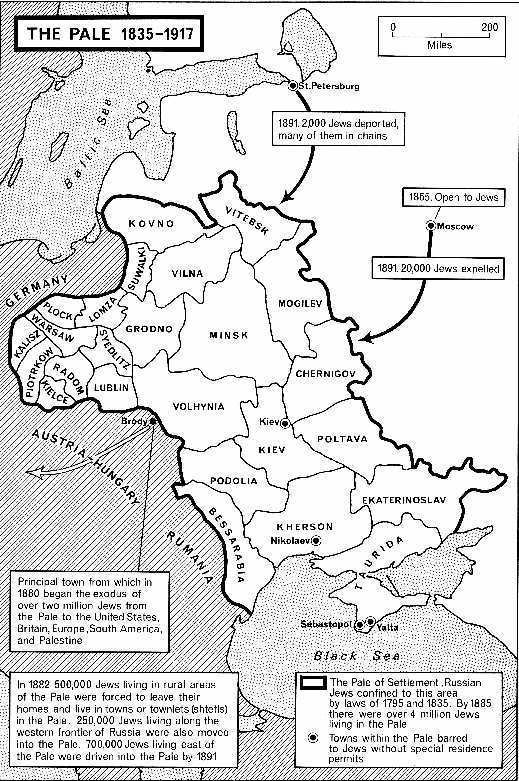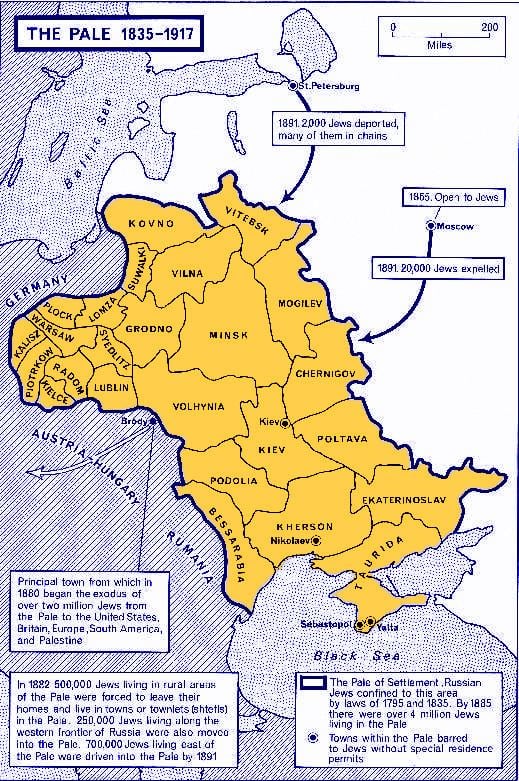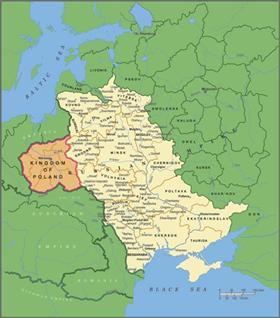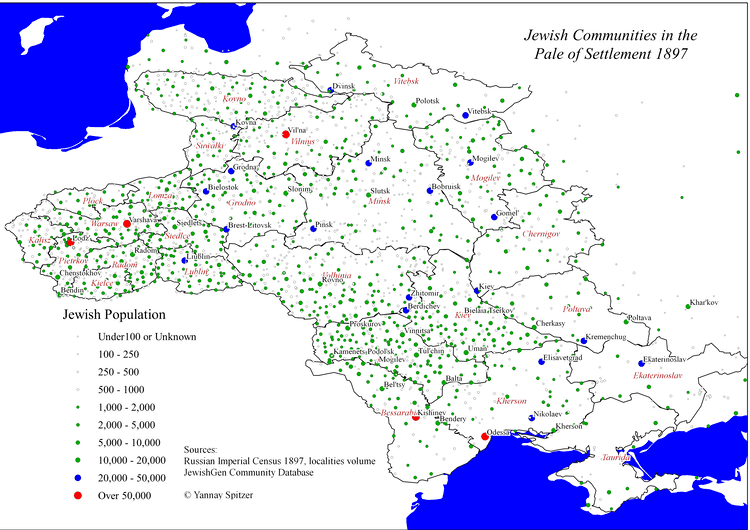 | ||
The pale of settlement this week in jewish history dr henry abramson
The Pale of Settlement (Russian: Черта́ осе́длости, chertá osédlosti, Yiddish: דער תּחום-המושבֿ, der tkhum-ha-moyshəv, Hebrew: תְּחוּם הַמּוֹשָב, tẖum hammosháv) was a western region of Imperial Russia with varying borders that existed from 1791 to 1917, in which permanent residency by Jews was allowed and beyond which Jewish permanent residency was generally prohibited. However, Jews were excluded from residency in a number of cities within the Pale, and a limited number of categories of Jews—those ennobled, with university educations or at university, members of the most affluent of the merchant guilds and particular artisans, some military personnel and some services associated with them, as well as the families, and sometimes the servants of these—were allowed to live outside it. The archaic English term pale is derived from the Latin word palus, a stake, extended to mean the area enclosed by a fence or boundary.
Contents
- The pale of settlement this week in jewish history dr henry abramson
- Pale of settlement
- History
- Jewish life in the Pale
- Territories of the Pale
- 1791
- 1794
- 1795
- 18051835
- Final demographics
- References

The Pale of Settlement included much of present-day Latvia and Lithuania (Baltic states); Belarus, Ukraine, Moldova, and Poland (East-Central Europe); and parts of western Russia. It extended from the eastern pale, or demarcation line, to the western Russian border with the Kingdom of Prussia (later the German Empire) and with Austria-Hungary. Furthermore, it comprised about 20% of the territory of European Russia and largely corresponded to historical borders of the former Polish–Lithuanian Commonwealth and the Crimean Khanate.

The Russian Empire in the period of the existence of the Pale was predominantly Orthodox Christian. The area included in the Pale, with its large Jewish and Catholic populations, was acquired through a series of military conquests and diplomatic maneuvers, between 1791 and 1835. While the religious nature of the edicts creating the Pale are clear (conversion to Russian Orthodoxy, the state religion, released individuals from the strictures), historians argue that the motivations for its creation and maintenance were primarily economic and nationalistic in nature.

The end of the enforcement and formal demarcation of the Pale coincided with the beginning of the First World War, and ultimately with the February and October Revolutions of 1917, i.e., the fall of the Russian Empire.

Pale of settlement
History

The Pale was first created by Catherine the Great in 1791, after several failed attempts by her predecessors, notably the Empress Elizabeth, to remove Jews from Russia entirely, unless they converted to Russian Orthodoxy, the state religion.

The institution of the Pale became more significant following the Second Partition of Poland in 1793, since, until then, Russia's Jewish population had been rather limited; the dramatic westward expansion of the Russian Empire through the annexation of Polish-Lithuanian territory substantially increased the Jewish population. At its height, the Pale, including the new Polish and Lithuanian territories, had a Jewish population of over five million, and represented the largest component (40 percent) of the world Jewish population at that time.
From 1791 to 1835, and until 1917, there were differing reconfigurations of the boundaries of the Pale, such that certain areas were variously open or shut to Jewish residency, such as the Caucasus. At times, Jews were forbidden to live in agricultural communities, or certain cities, (as in Kiev, Sevastopol and Yalta), and were forced to move to small provincial towns, thus fostering the rise of the shtetls. Jewish merchants of the First Guild (купцы первой гильдии, the wealthiest sosloviye of merchants in the Russian Empire), people with higher or special education, University students, artisans, army tailors, ennobled Jews, soldiers (drafted in accordance with the Recruit Charter of 1810), and their families had the right to live outside the Pale of Settlement. In some periods, special dispensations were given for Jews to live in the major imperial cities, but these were tenuous, and several thousand Jews were expelled to the Pale from Saint Petersburg and Moscow as late as 1891.
During World War I, the Pale lost its rigid hold on the Jewish population when large numbers of Jews fled into the Russian interior to escape the invading German army. On March 20 (April 2 N.S.), 1917, the Pale was abolished by the Provisional Government decree, On abolition of confessional and national restrictions (Russian: Об отмене вероисповедных и национальных ограничений). A large portion of the Pale, together with its Jewish population, became part of Poland. Subsequently, most of this population would perish in The Holocaust one generation later.
Jewish life in the Pale
Jewish life in the shtetls (Yiddish: שטעטלעך shtetlekh "little towns") of the Pale of Settlement was hard and poverty-stricken. Following the Jewish religious tradition of tzedakah (charity), a sophisticated system of volunteer Jewish social welfare organizations developed to meet the needs of the population. Various organizations supplied clothes to poor students, provided kosher food to Jewish soldiers conscripted into the Tsar's army, dispensed free medical treatment for the poor, offered dowries and household gifts to destitute brides, and arranged for technical education for orphans. According to historian Martin Gilbert's Atlas of Jewish History, no province in the Pale had less than 14% of Jews on relief; Lithuanian and Ukrainian Jews supported as much as 22% of their poor populations.
The concentration of Jews in the Pale made them easy targets for pogroms and anti-Jewish riots by the majority population; these, along with the repressive May Laws, often devastated whole communities. Though attacks occurred throughout the existence of the Pale, particularly devastating anti-Jewish pogroms occurred from 1881–83 and from 1903–1906, targeting hundreds of communities, assaulting thousands of Jews, and causing considerable property damage.
One outgrowth of the concentration of Jews in a circumscribed area was the development of the modern yeshiva system. Until the beginning of the 19th century, each town supported its own advanced students who learned in the local synagogue with the rabbinical head of the community. Each student would eat his meals in a different home each day, a system known as essen teg ("eating days").
After 1886, the Jewish quota was applied to education, with the percentage of Jewish students limited to no more than 10% within the Pale, 5% outside the Pale and 3% in the capitals of Moscow, St. Petersburg, and Kiev. The quotas in the capitals, however, were increased slightly in 1908 and 1915.
Amidst the difficult conditions in which the Jewish population lived and worked, the courts of Hasidic dynasties flourished in the Pale. Thousands of followers of rebbes such as the Gerrer Rebbe Yehudah Aryeh Leib Alter (known as the Sfas Emes), the Chernobyler Rebbe, and the Vizhnitzer Rebbe flocked to their towns for the Jewish holidays and followed their rebbes' minhagim (Jewish practices) in their own homes.
The tribulations of Jewish life in the Pale of Settlement were immortalized in the writings of Yiddish authors such as humorist Sholom Aleichem, whose novel Tevye der Milchiger (Tevye the Milkman) (in the form of the narration of Tevye from a fictional shtetl of Anatevka to the author) form the basis of the theatrical (and subsequent film) production Fiddler on the Roof. Because of the harsh conditions of day-to-day life in the Pale, some two million Jews emigrated from there between 1881 and 1914, mainly to the United States. However, this exodus did not affect the stability of the Jewish population of the Pale, which remained at 5 million people due to its high birthrate.
Territories of the Pale
The Pale of Settlement included the following areas.
1791
The ukase of Catherine the Great of December 23, 1791 limited the Pale to:
1794
After the Second Partition of Poland, the ukase of June 23, 1794, the following areas were added:
1795
After the Third Partition of Poland, the following areas were added:
1805–1835
After 1805 the Pale gradually shrank, and became limited to the following areas:
Congress Poland did not belong to the Pale of Settlement
Rural areas for 50 versts (53 km) from the western border were closed for new settlement of the Jews.
Final demographics
According to the 1897 census, the guberniyas had the following percentages of Jews:
- Vilna Governorate [12.86%]
- Kovno Governorate [13.77%]
- Grodno Governorate [17.49%]
- Minsk Governorate [16.06%]
- Mogilev Governorate [12.09%]
- Vitebsk Governorate (some parts of it are in Pskov and Smolensk Oblasts now) [11.79%]
- Kiev Governorate [12.19%]
- Volhynian Governorate [13.24%]
- Podolia Governorate [12.28%]
- Warsaw guberniya (Варшавская губерния (Мазовецкая губерния 1837–44)) [18.22%]
- Lublin guberniya (Люблинская губерния) [13.46%]
- Płock guberniya (Плоцкая губерния) [9.29%]
- Kalisz guberniya (Калишская губерния) [8.52%]
- Piotrkow guberniya (Пётроковская губерния) [15.85%]
- Kielce guberniya (Келецкая губерния (Краковская губерния 1837–44)) [10.92%]
- Radom guberniya (Радомская губерния) [13.78%]
- Siedlce guberniya (Седлецкая губерния (Подлясская губерния 1837–44)) [15.69%]
- Augustów guberniya (Августовская губерния, 1837–67), split into:
- Suwałki guberniya (Сувалкская губерния) [10.16%]
- Łomża guberniya (Ломжинская губерния) [15.77%]
Others:
- Chernigov Governorate (some parts of it are in Bryansk Oblast now) [4.98%]
- Poltava Governorate [3.99%]
- Taurida Governorate (Crimea) [Jewish 4.20% + Karaite 0.43%]
- Kherson Governorate [12.43%]
- Bessarabia Governorate [11.81%]
- Yekaterinoslav Governorate [4.78%]
In 1882 it was forbidden for Jews to settle in rural areas.
The following cities within the Pale were excluded from it:
